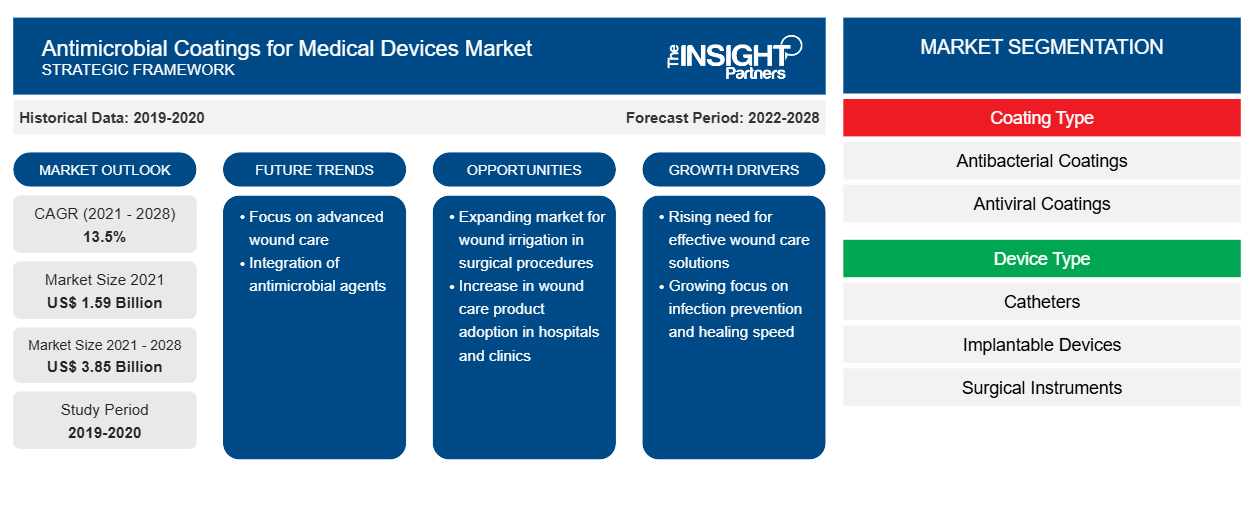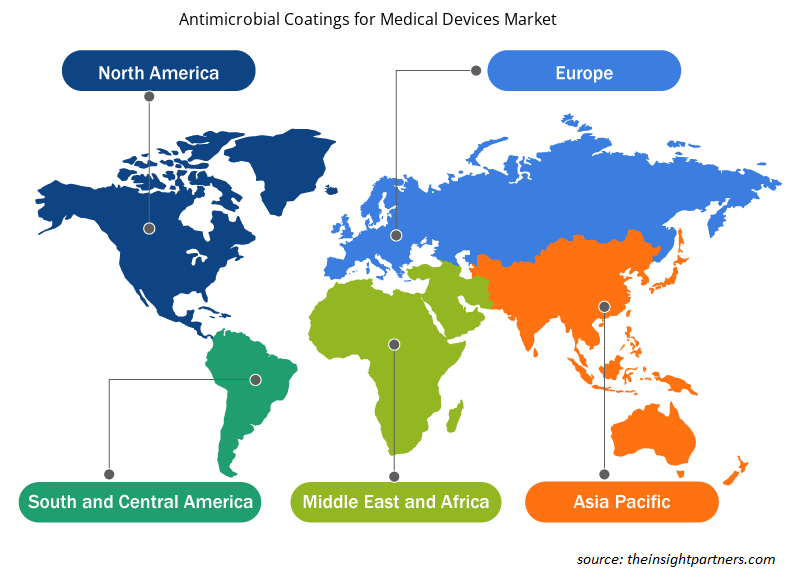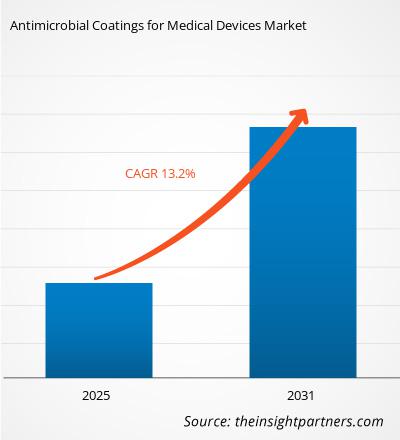من المتوقع أن يصل حجم سوق الطلاءات المضادة للميكروبات للأجهزة الطبية إلى 6.49 مليار دولار أمريكي بحلول عام 2031، مقارنةً بـ 2.80 مليار دولار أمريكي في عام 2024. ومن المتوقع أن يسجل السوق معدل نمو سنوي مركب قدره 13.2% خلال الفترة 2025-2031. ومن المرجح أن يظل دمج تقنية النانو اتجاهًا رئيسيًا في سوق الطلاءات المضادة للميكروبات للأجهزة الطبية.
تحليل سوق الطلاءات المضادة للميكروبات للأجهزة الطبية
من المتوقع أن يشهد سوق الطلاءات المضادة للميكروبات للأجهزة الطبية نموًا كبيرًا في السنوات القادمة نظرًا لارتفاع معدل انتشار العدوى المرتبطة بالرعاية الصحية، وتزايد الطلب على التقنيات الطبية المتقدمة، والتركيز المتزايد على سلامة المرضى. يستثمر اللاعبون الرئيسيون في السوق في البحث والتطوير لتطوير طلاءات مضادة للميكروبات مبتكرة ذات فعالية ومتانة مُحسّنة. ومن المتوقع أن تهيمن أمريكا الشمالية وأوروبا على السوق جغرافيًا بفضل وجود بنية تحتية راسخة للرعاية الصحية ولوائح صارمة بشأن استخدام الطلاءات المضادة للميكروبات في الأجهزة الطبية.
نظرة عامة على سوق الطلاءات المضادة للميكروبات للأجهزة الطبية
تُطبّق الطلاءات المضادة للميكروبات على الأجهزة الطبية، مثل القسطرة والغرسات والأدوات الجراحية، لمنع نمو الكائنات الدقيقة الضارة وتقليل خطر العدوى. يمكن تصنيع هذه الطلاءات من مواد متنوعة، بما في ذلك الفضة والنحاس ومركبات الأمونيوم الرباعية، ولكل منها خصائص وفعالية فريدة. ويعود تقدم السوق إلى عوامل مثل تزايد الوعي بأهمية مكافحة العدوى، والاعتماد المتزايد على الإجراءات الجراحية طفيفة التوغل، والطلب المتزايد على الأجهزة الطبية المتقدمة التي يمكنها منع انتشار الأمراض المعدية. في فرنسا، تُقدّم الحكومة دعمًا اقتصاديًا كبيرًا للأبحاث المتعلقة بالطلاءات المضادة للميكروبات. على سبيل المثال، في فبراير 2022، حصلت شركة SPARTHA Medical، وهي شركة فرنسية متخصصة في التكنولوجيا الطبية تُقدّم طلاءات متعددة الوظائف مضادة للميكروبات والفيروسات والالتهابات، على منحة قدرها 2.4 مليون يورو (2.75 مليون دولار أمريكي)، بالإضافة إلى تمويل إضافي غير مُعلن من صندوق مجلس الابتكار الأوروبي (EIC). بالإضافة إلى ذلك، أعلنت شركة سبارثا الطبية في ديسمبر 2021 عن إتمام جولتها الأولى من التمويل بقيمة 1.4 مليون يورو (1.44 مليون دولار أمريكي) لتطوير طلاءات مُخصصة. ويُشار إلى أن مُصنّعي الأجهزة الطبية الفرنسيين يُقدّرون مساهمتهم المُحتملة في نجاح التعامل مع جائحة كوفيد-19 بفعالية، والحفاظ على نسبة وارداتهم وصادراتهم خلال الأزمة المالية. وبالمثل، تفتخر ألمانيا بنظام رعاية صحية قوي يُدير علاج آلاف المرضى يوميًا. كما تُشدد اللجنة الألمانية على أهمية نظافة المستشفيات ومكافحة العدوى، مُقدمةً توصيات قيّمة تُشجع على تطوير واعتماد طلاءات فعالة مضادة للميكروبات.
قم بتخصيص هذا التقرير ليناسب متطلباتك
ستحصل على تخصيص لأي تقرير - مجانًا - بما في ذلك أجزاء من هذا التقرير، أو تحليل على مستوى الدولة، وحزمة بيانات Excel، بالإضافة إلى الاستفادة من العروض والخصومات الرائعة للشركات الناشئة والجامعات
سوق الطلاءات المضادة للميكروبات للأجهزة الطبية: رؤى استراتيجية

- احصل على أهم اتجاهات السوق الرئيسية لهذا التقرير.ستتضمن هذه العينة المجانية تحليل البيانات، بدءًا من اتجاهات السوق وحتى التقديرات والتوقعات.
عوامل السوق والفرص المتاحة لطلاءات مضادات الميكروبات للأجهزة الطبية
ارتفاع معدل انتشار العدوى المكتسبة من المستشفيات يعزز نمو السوق
تشمل العدوى المكتسبة من المستشفيات/المرتبطة بالرعاية الصحية (HAIs) عدوى المسالك البولية المرتبطة بالقسطرة (CAUTI)، والتهابات مجرى الدم المرتبطة بالقسطرة المركزية، والالتهاب الرئوي المرتبط بأجهزة التنفس الصناعي. يمكن أن تنشأ هذه العدوى أيضًا في مواقع الجراحة، والمعروفة باسم عدوى مواقع الجراحة (SSIs). تفرض العدوى المكتسبة من المستشفيات عبئًا اقتصاديًا كبيرًا على نظام الرعاية الصحية. ووفقًا لوزارة الصحة والخدمات الإنسانية الأمريكية، فإن الانتشار المتزايد للعدوى المكتسبة من المستشفيات (والتي تصيب ما يقرب من مريض واحد من كل 31 مريضًا في المستشفى) والتركيز المتزايد على مكافحة العدوى يدفعان الطلب على حلول مضادة للبكتيريا المتقدمة. علاوة على ذلك، تُدرج مراكز السيطرة على الأمراض والوقاية منها (CDC) عدوى المسالك البولية المكتسبة من المستشفيات ضمن أكثر عدوى المستشفيات شيوعًا. ترتبط عدوى المسالك البولية المكتسبة من المستشفيات بزيادة معدلات الاعتلال والوفيات وتكاليف الرعاية الصحية وطول مدة الإقامة في المستشفى. ووفقًا لمراكز السيطرة على الأمراض والوقاية منها، يتلقى ما بين 15% و25% من المرضى في المستشفيات قسطرة بولية أثناء إقامتهم، وهي مرتبطة بحوالي 75% من عدوى المسالك البولية المكتسبة في المستشفيات. يمكن أن يُساعد استخدام الطلاءات المضادة للبكتيريا على القسطرات في الحد من حدوث هذه العدوى عن طريق تثبيط استعمار البكتيريا. ويعزز الوعي المتزايد بمكافحة العدوى ، وزيادة عدد العمليات الجراحية، والانتشار المتزايد للأمراض المزمنة التي غالبًا ما تتطلب قسطرة لدى المرضى، نمو سوق الطلاءات المضادة للبكتيريا للأجهزة الطبية.
مبادرات التمويل من قبل المنظمات العامة والخاصة لخلق فرص النمو
في فبراير 2022، حصلت شركة سبارثا ميديكال على منحة قدرها 2.75 مليون دولار أمريكي من المجلس الأوروبي للابتكار. وكانت الشركة تخطط لاستخدام هذه الأموال لتطوير طلاءاتها المضادة للميكروبات والفيروسات والالتهابات؛ وإطلاق التجارب السريرية؛ وبناء بنيتها التحتية وفريق عملها؛ ومواصلة تطوير تقنية الطلاء. وفي وقت سابق من عام 2020، نشر باحثون في مركز البحوث التعاونية في المواد الحيوية (CIC biomaGUNE، إسبانيا) مشروعًا بحثيًا بعنوان "طلاءات مضادة للبكتيريا طبقة تلو الأخرى للغرسات الطبية". وكشفت الدراسة عن كفاءة تقنية الطلاء طبقة تلو الأخرى التي توفر إمكانيات متعددة لتطبيق الطلاءات المضادة للبكتيريا على الغرسات. وقد موّل مشروع MAT2017-88752-R Retos التابع لوزارة الاقتصاد الإسبانية هذا البحث. وتوفر هذه الأموال التي توفرها المؤسسات العامة والخاصة الدعم للبحث والتطوير والدراسات السريرية المتعلقة بالطلاءات المضادة للميكروبات، والتي من المرجح أن تُفيد سوق الطلاءات المضادة للميكروبات للأجهزة الطبية في السنوات القادمة. كما أن الارتفاع في التمويل والاستثمارات يخلق فرصًا للوافدين الجدد واللاعبين في الأسواق الناشئة.
تقرير تحليل تجزئة سوق الطلاءات المضادة للميكروبات للأجهزة الطبية
القطاعات الرئيسية التي تشكل أساس تحليل سوق الطلاءات المضادة للميكروبات للأجهزة الطبية هي المادة ونوع الطلاء ونوع الجهاز والتطبيق والمستخدم النهائي.
- بناءً على المادة، يُصنف سوق الطلاءات المضادة للميكروبات للأجهزة الطبية إلى طلاءات معدنية وطلاءات غير معدنية. وقد استحوذ قطاع الطلاءات المعدنية على حصة أكبر من السوق في عام ٢٠٢٤.
- حسب نوع الطلاء، يُقسّم السوق إلى طلاءات مضادة للبكتيريا، وطلاءات مضادة للفيروسات، وغيرها. وقد استحوذ قطاع الطلاءات المضادة للبكتيريا على أكبر حصة سوقية للطلاءات المضادة للميكروبات للأجهزة الطبية في عام 2024.
- من حيث نوع الجهاز، يُقسّم سوق الطلاءات المضادة للميكروبات للأجهزة الطبية إلى قسطرة، وأجهزة قابلة للزرع، وأدوات جراحية، وغيرها. وقد هيمن قطاع الأجهزة القابلة للزرع على السوق في عام ٢٠٢٤.
- بناءً على التطبيق، يُقسّم سوق الطلاءات المضادة للميكروبات للأجهزة الطبية إلى الجراحة العامة، وأمراض القلب والأوعية الدموية، وجراحة العظام، وأمراض النساء، وطب الأسنان، وغيرها. وقد استحوذ قطاع أمراض القلب والأوعية الدموية على الحصة الأكبر من السوق في عام 2024.
- بحسب المستخدم النهائي، يُصنف السوق إلى مُصنِّعي الأجهزة الطبية، ومُصنِّعي العقود، ومُقدِّمي الخدمات. وقد حاز قطاع مُصنِّعي الأجهزة الطبية على أكبر حصة في سوق الطلاءات المضادة للميكروبات للأجهزة الطبية في عام ٢٠٢٤.
تحليل حصة سوق الطلاءات المضادة للميكروبات للأجهزة الطبية حسب المنطقة الجغرافية
ينقسم النطاق الجغرافي لتقرير سوق الطلاءات المضادة للميكروبات للأجهزة الطبية إلى خمس مناطق: أمريكا الشمالية، وآسيا والمحيط الهادئ، وأوروبا، والشرق الأوسط وأفريقيا، وأمريكا الجنوبية والوسطى.
استحوذت أمريكا الشمالية على حصة كبيرة من السوق في عام 2024. ويؤكد الانتشار المتزايد للعدوى المرتبطة بالرعاية الصحية على الحاجة إلى تطوير أجهزة طبية مزودة بطلاءات مضادة للميكروبات في هذه المنطقة. قد تحدث العدوى المرتبطة بالرعاية الصحية في جميع أنواع مرافق الرعاية الصحية، بما في ذلك مراكز الجراحة الخارجية، ومرافق غسيل الكلى، ومستشفيات الرعاية الحادة، والرعاية الخارجية (مثل عيادات الأطباء وعيادات الرعاية الصحية)، ومرافق الرعاية طويلة الأجل (مثل دور رعاية المسنين ومرافق إعادة التأهيل). ووفقًا لوزارة الصحة والخدمات الإنسانية الأمريكية، يُصاب مريض واحد من كل 25 مريضًا في المستشفيات بالعدوى المرتبطة بالرعاية الصحية في أي وقت في الولايات المتحدة. وفي المستشفيات الأمريكية وحدها، توقعت مراكز السيطرة على الأمراض والوقاية منها أن تُسبب العدوى المرتبطة بالرعاية الصحية ما يُقدر بـ 1.7 مليون إصابة و99,000 حالة وفاة مرتبطة بها سنويًا، مما يشير إلى آفاق نمو سوق الطلاءات المضادة للميكروبات للأجهزة الطبية.
رؤى إقليمية حول سوق الطلاءات المضادة للميكروبات للأجهزة الطبية
قام محللو شركة إنسايت بارتنرز بشرح شامل للاتجاهات والعوامل الإقليمية المؤثرة في سوق الطلاءات المضادة للميكروبات للأجهزة الطبية خلال فترة التوقعات. ويناقش هذا القسم أيضًا قطاعات سوق الطلاءات المضادة للميكروبات للأجهزة الطبية ومناطقها الجغرافية في أمريكا الشمالية، وأوروبا، وآسيا والمحيط الهادئ، والشرق الأوسط وأفريقيا، وأمريكا الجنوبية والوسطى.

- احصل على البيانات الإقليمية المحددة لسوق الطلاءات المضادة للميكروبات للأجهزة الطبية
نطاق تقرير سوق الطلاءات المضادة للميكروبات للأجهزة الطبية
| سمة التقرير | تفاصيل |
|---|---|
| حجم السوق في عام 2024 | 2.80 مليار دولار أمريكي |
| حجم السوق بحلول عام 2031 | 6.49 مليار دولار أمريكي |
| معدل النمو السنوي المركب العالمي (2025 - 2031) | 13.2% |
| البيانات التاريخية | 2021-2023 |
| فترة التنبؤ | 2025-2031 |
| القطاعات المغطاة | حسب المادة
|
| المناطق والدول المغطاة | أمريكا الشمالية
|
| قادة السوق وملفات تعريف الشركات الرئيسية |
|
كثافة اللاعبين في سوق الطلاءات المضادة للميكروبات للأجهزة الطبية: فهم تأثيرها على ديناميكيات الأعمال
يشهد سوق الطلاءات المضادة للميكروبات للأجهزة الطبية نموًا متسارعًا، مدفوعًا بتزايد طلب المستخدمين النهائيين نتيجةً لعوامل مثل تفضيلات المستهلكين المتطورة، والتقدم التكنولوجي، وزيادة الوعي بفوائد المنتج. ومع تزايد الطلب، تعمل الشركات على توسيع عروضها، والابتكار لتلبية احتياجات المستهلكين، والاستفادة من الاتجاهات الناشئة، مما يُعزز نمو السوق.
تشير كثافة اللاعبين في السوق إلى توزيع الشركات العاملة في سوق أو قطاع معين. وتشير إلى عدد المنافسين (اللاعبين في السوق) الموجودين في سوق معين نسبةً إلى حجمه أو قيمته السوقية الإجمالية.
الشركات الرئيسية العاملة في سوق الطلاءات المضادة للميكروبات للأجهزة الطبية هي:
- شركة شيروين ويليامز
- شركة بي بي جي للصناعات
- شركة سايتاكوت ايه بي
- شركة كوفالون للتكنولوجيا المحدودة
- كونينكليكه DSM NV
- شركة أنظمة الطلاء المتخصصة
إخلاء المسؤولية : الشركات المذكورة أعلاه ليست مرتبة بأي ترتيب معين.

- احصل على نظرة عامة على أهم اللاعبين الرئيسيين في سوق الطلاءات المضادة للميكروبات للأجهزة الطبية
أخبار سوق الطلاءات المضادة للميكروبات للأجهزة الطبية والتطورات الأخيرة
يُقيّم سوق الطلاءات المضادة للميكروبات للأجهزة الطبية من خلال جمع بيانات نوعية وكمية بعد البحث الأولي والثانوي، والتي تشمل منشورات الشركات المهمة، وبيانات الجمعيات، وقواعد البيانات. فيما يلي بعض التطورات في السوق:
- أطلقت شركة هيدرومر، المُصنِّعة لتقنيات الطلاء المُحبّة للماء والمقاومة للجلطات والمضادة للميكروبات للأجهزة الطبية، منتج هيدروثرومب إكس، وهو نسخة من الجيل التالي من منتج الشركة القديم F200t. يُعدّ F200t طلاءً مُقاومًا للجلطات، معروفًا بقدرته الكبيرة على تقليل التصاق الصفائح الدموية وانقسام الخلايا، مما يُساعد في الوقاية من عودة تضيق الأوعية الدموية. (المصدر: بيان صحفي لشركة هيدرومر، يونيو 2024)
- أعلنت شركة بيوانترأكشن عن إطلاق طلاء ترايدانت المضاد للميكروبات. يتضمن ترايدانت مكونات فعالة وسلبية. ووفقًا لبيو إنترأكشنز، يُعد المنتج الجديد طلاءً لا يرشح، ويوفر مقاومة للعدوى على السطح ويقلل من خطر تكوّن الأغشية الحيوية، كل ذلك بدون أي مكونات سامة أو مُستخلصة. يستهدف هذا الطلاء طيفًا واسعًا من البكتيريا، مما يقلل بشكل كبير من خطر العدوى. تُسوّق بيوانترأكشنز ترايدانت للاستخدام على القسطرة الوريدية والمبولية، والعدسات اللاصقة، وجراحة الجمجمة المصنوعة من التيتانيوم، وضمادات الجروح، والملصقات، والطلاء الواقي للسفن. (المصدر: بيوانترأكشنز المحدودة، بيان صحفي، أبريل 2022)
تقرير سوق الطلاءات المضادة للميكروبات للأجهزة الطبية: التغطية والنتائج المتوقعة
يقدم تقرير "حجم سوق الطلاءات المضادة للميكروبات للأجهزة الطبية وتوقعاتها (2021-2031)" تحليلاً مفصلاً للسوق يغطي المجالات التالية:
- حجم سوق الطلاءات المضادة للميكروبات للأجهزة الطبية وتوقعاتها على المستويات العالمية والإقليمية والوطنية لجميع قطاعات السوق الرئيسية التي يغطيها النطاق
- اتجاهات سوق الطلاءات المضادة للميكروبات للأجهزة الطبية وديناميكيات السوق مثل العوامل المحركة والقيود والفرص الرئيسية
- تحليل مفصل لـ PEST و SWOT
- تحليل سوق الطلاءات المضادة للميكروبات للأجهزة الطبية يغطي اتجاهات السوق الرئيسية والإطار العالمي والإقليمي والجهات الفاعلة الرئيسية واللوائح والتطورات الأخيرة في السوق
- تحليل المشهد الصناعي والمنافسة الذي يغطي تركيز السوق، وتحليل خريطة الحرارة، واللاعبين البارزين، والتطورات الأخيرة في سوق الطلاءات المضادة للميكروبات للأجهزة الطبية
- ملفات تعريف الشركة التفصيلية
- التحليل التاريخي (سنتان)، سنة الأساس، التوقعات (7 سنوات) مع معدل النمو السنوي المركب
- تحليل PEST و SWOT
- حجم السوق والقيمة / الحجم - عالمي، إقليمي، بلد
- الصناعة والمنافسة
- مجموعة بيانات إكسل
التقارير الحديثة
تقارير ذات صلة
شهادات العملاء
سبب الشراء
- اتخاذ قرارات مدروسة
- فهم ديناميكيات السوق
- تحليل المنافسة
- رؤى العملاء
- توقعات السوق
- تخفيف المخاطر
- التخطيط الاستراتيجي
- مبررات الاستثمار
- تحديد الأسواق الناشئة
- تحسين استراتيجيات التسويق
- تعزيز الكفاءة التشغيلية
- مواكبة التوجهات التنظيمية






















 احصل على عينة مجانية ل - سوق الطلاءات المضادة للميكروبات للأجهزة الطبية
احصل على عينة مجانية ل - سوق الطلاءات المضادة للميكروبات للأجهزة الطبية